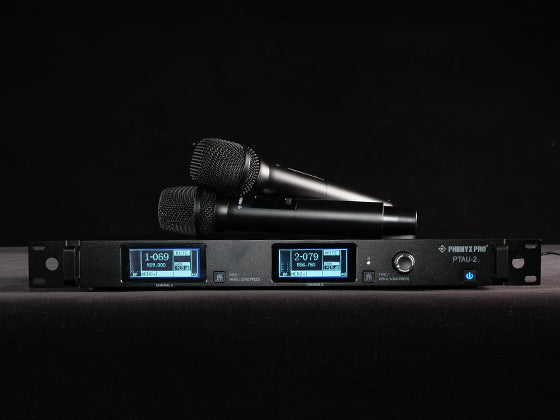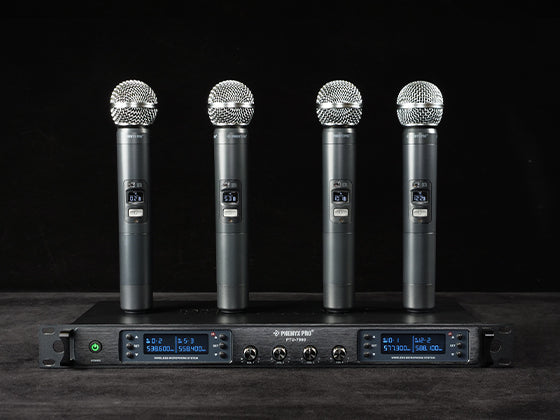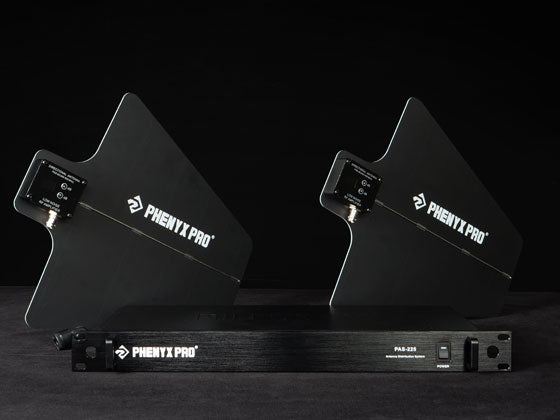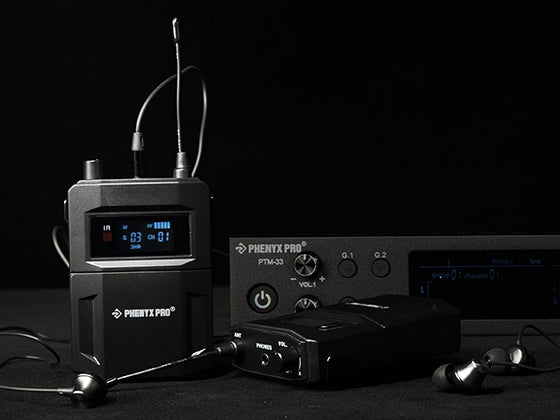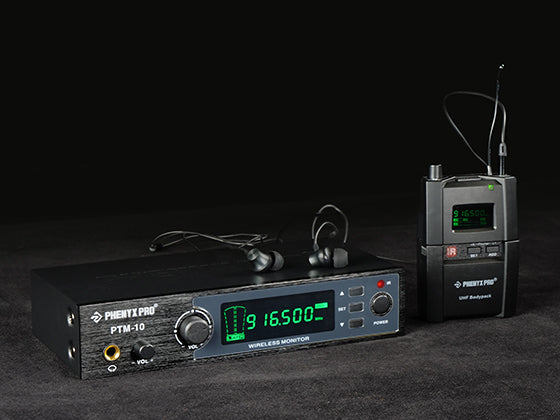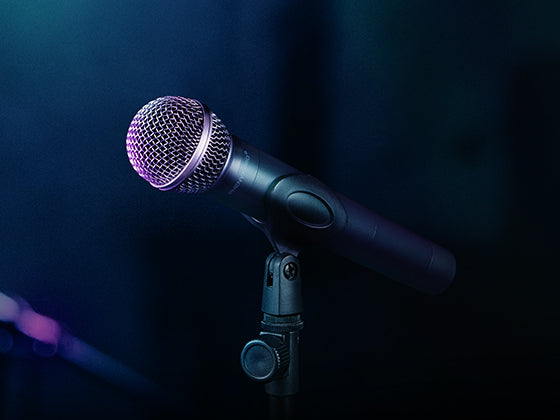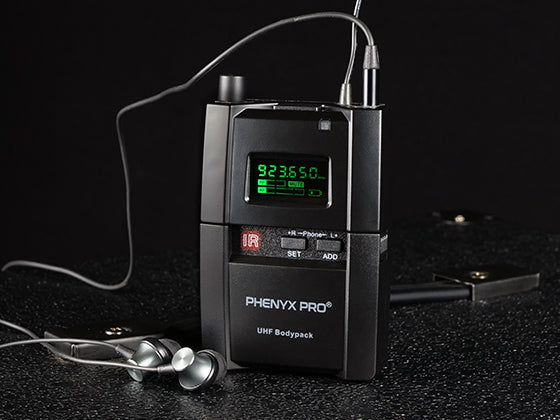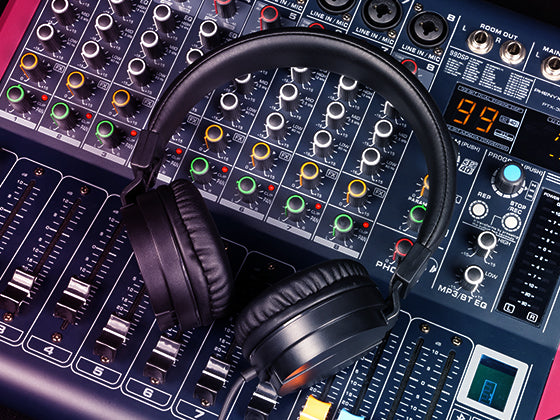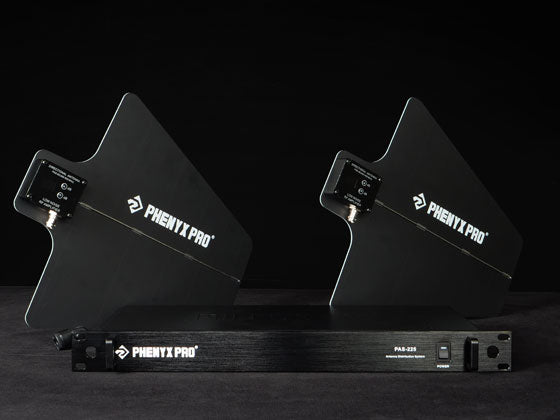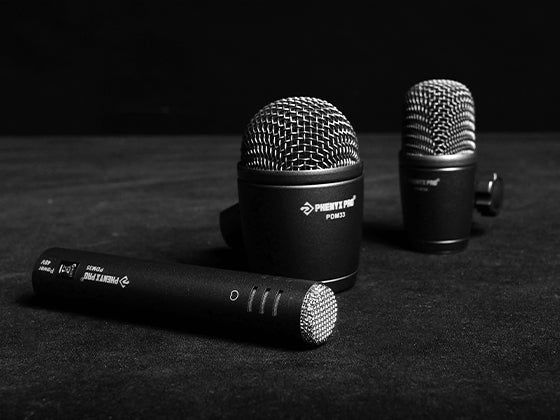Essential Microphone Specs You Need to Know
A basic understanding of microphones can help you choose the right gear for your events. In this article, we’ll introduce the most common microphone types and the key specifications that matter.

You may find yourself confused by all the technical terms in a microphone manual — unsure how each specification actually impacts performance. Take our upcoming PM-25 wired vocal microphone, for example: what makes it capable of smooth vocal reproduction, easy drivability, and handling high-SPL environments?
In this article, we’ll walk you through the most common microphone types and the key specifications worth knowing. By the end, we believe your confusion will turn into clarity.
1.Microphone Types
A microphone is actually a transducer—it converts acoustic energy into electrical energy. As such, microphones are classified by how they perform this energy conversion. While there are many ways to convert sound into an electrical signal, we’ll focus on the two most popular types: dynamic and condenser.
-Dynamic Microphone
Dynamic microphones consist of a diaphragm, voice coil, and magnet that form a sound-driven electrical generator. They operate on the following principle: as sound waves strike the diaphragm, the attached voice coil moves within the magnetic field, generating an electrical signal that mirrors the original sound waves.
This design brings several practical advantages. With lower sensitivity, dynamic mics can handle high sound pressure levels without distortion—making them ideal for live performances and loud environments. Due to their relatively simple construction, they are also more durable and reliable, with minimal maintenance required to ensure consistent performance.

-Condenser Microphone
Condenser microphone elements use a conductive diaphragm and an electrically charged backplate to form a sound-sensitive capacitor. They function on the following principle: As the diaphragm vibrates in response to sound waves, the distance between the mic and backplate fluctuates within the electrical field to create the signal. To process the signal, all condenser microphones include active electronic circuitry—commonly referred to as a preamp—which requires phantom power or a battery to operate.
Compared to dynamic microphones, condenser microphones have higher sensitivity and a wider frequency response, enabling them to capture more detail from the sound source. With these capabilities, they are well-suited for recording acoustic instruments and sampling sound effects.

Other types, such as ribbon or carbon microphones, also exist but are less commonly used due to their fragility, limited applications, or higher cost. Considering that most of our customers are performers, educators, and content creators who often work in live or mobile environments, the majority of Phenyx Pro microphones are dynamic models.
2.Main Specifications
The specifications of a microphone typically include the following factors, each of which directly affects its performance, sound quality, and applications.
- Frequency Response
- Sensitivity
- Impedance
- Polar Pattern
- Self-Noise
- Signal-to-Noise Ratio
- Maximum Sound Pressure Level
- Dynamic Range
-Frequency Response
Frequency response refers to the range of frequencies a microphone can reproduce. Human hearing typically ranges from 20Hz to 20kHz, which is why many microphones have a frequency response that falls within this range. The frequency response is generally represented by a line graph, with frequency on the x-axis and output level on the y-axis. Bass frequencies range from 20Hz to around 300Hz, mid-frequencies cover 300Hz to 4kHz, and treble frequencies lie in the 4kHz to 20kHz range. By examining the response curve, you can identify which frequencies are accented or diminished, and select microphones for particular applications. The two most common types are flat response and shaped response.
A flat response microphone has equal sensitivity across all frequencies, without boosting or attenuating any specific range, so its response curve appears nearly horizontal on a graph. When recording acoustic instruments such as violins or pianos, a flat response microphone is preferred, as it allows for accurate reproduction of the original sound source.
Shaped response microphones boost or attenuate specific frequency ranges, creating a response curve with noticeable peaks and dips. This type of tuning suits various applications. For vocals, a microphone that reduces low frequencies and enhances the upper mids can help minimize proximity rumble and improve presence and clarity. In contrast, a kick drum microphone typically emphasizes low-end frequencies to produce a deeper, more powerful sound.
-Sensitivity
Microphone sensitivity is the amount of output voltage for a given sound pressure input. Microphone manufacturers typically use 1 Pa (Pascal), which is equal to 94 dB SPL, as a reference sound pressure. The resulting output voltage (measured in mV) under this condition is the sensitivity value, stated in mV/Pa. For easier comparison, this value can also be expressed in dBV. Due to the low output voltage of microphones relative to the 1V reference level used in dBV, the sensitivity value is typically negative. The closer the value is to 0, the higher the sensitivity—for example, -45 dBV indicates higher sensitivity than -50 dBV.
Condenser microphones typically feature higher sensitivity (-32 dBV to -38 dBV), making them very useful in low sound pressure level applications, such as recording dialogue or vocals.
Otherwise, dynamic microphones have lower sensitivity (–50 dBV to –60 dBV). One example is our newly released PM-25 dynamic vocal microphone. With a sensitivity of –50 dBV, it performs well in high sound pressure level applications like capturing guitar amps, drums, and more.
-Impedance
Impedance is mainly specified for wired microphones due to their direct connection to audio devices. Although wireless mics also have internal impedance, it is usually not disclosed or necessary for user consideration.
Impedance is the AC resistance to audio signal voltage and is measured in ohms. It can be divided into low (50–1,000 ohms), medium (5,000–15,000 ohms) and high (20,000+ ohms) impedance. There are usually two impedance specs: output impedance and input impedance.
Output impedance is determined by the microphone. Most microphones are rated as low impedance (150~600Ω) for better compatibility with audio equipment such as mixers, preamplifiers, etc. Moreover, low-impedance microphones can support cable runs of nearly any practical length without noticeable sound degradation. In contrast, high-impedance microphones are limited in cable length—runs longer than about 20 feet can lead to high-frequency loss and a drop in output level.
Input impedance, also called load impedance, is determined by the connected audio device. To ensure proper signal transmission, the microphone’s output impedance must be appropriately bridged by the audio device’s input impedance—typically set to at least five times higher. So, if a microphone has an output impedance of 250 ohms, the preamp should have an input impedance of at least 1,250 ohms.
-Polar Pattern
Polar pattern describes how sensitive a microphone is to sound coming from various directions or angles. You’ll usually see this represented by a polar pattern graph, which shows how the microphone’s sensitivity varies as you move 360 degrees around it. The three most common patterns are omnidirectional, unidirectional, and bidirectional.
Omnidirectional microphones pick up sound from all directions equally. With their ability to capture a natural and open sound, omnidirectional mics are a good choice for recording acoustic instruments, choirs, and other sources in well-controlled environments. However, due to their lack of directionality, they are less effective in rejecting background noise and suppressing feedback, making them unsuitable for live performances or other applications in acoustically complex environments.

Unidirectional microphones are most sensitive to sound arriving from one particular direction. The main unidirectional types include cardioid, supercardioid, and hypercardioid.
Cardioid is the most widely used directional polar pattern. This polar pattern is highly sensitive to the front (0 degrees) and less sensitive to the rear (180 degrees). Compared to omnidirectional types, it captures the singer's voice precisely while blocking out unwanted noise from the stage—an ideal for feature live performances and touring setups.

Supercardioid and hypercardioid pattens offer narrower front pickup angles than the cardioid – 115 degrees for the supercardioid and 105 degrees for the hypercardioid. They can provide more focused pickup than the cardioid pattern with better rejection of ambient noise and feedback. Even so, both patterns do pick up a bit from the rear, so you'll need to be careful with mic placement.

Bidirectional microphones, also known as figure-of-eight devices, pick up an equal level of sound from the front and the rear, but block out sound from the sides. In situations like interviews and duets, these microphones can be useful.

-Self-Noise
The self-noise of a microphone is the amount of noise created by a microphone’s internal circuits. All circuits create a small amount of noise, which is usually inaudible in most recordings. But it may become a factor when recording low-volume sound sources. For broadcast, quiet, and critical recording applications, it’s best to choose a microphone with a self-noise rating of 15 dB(A) or lower.
-Signal-to-Noise Ratio (SNR)
In terms of numbers, an SNR above 70 dB is considered high-quality, providing clean and professional audio, while an SNR below 60 dB may lead to noticeable hiss and reduced clarity.
Signal-to-noise ratio (SNR) measures the level of the desired signal relative to the microphone’s self-noise. When the incoming audio signal is stronger than the microphone’s self-noise, unwanted sound becomes less noticeable—this indicates a high-quality SNR. But if the input signal is weak, it will sit closer to the self-noise level, resulting in a poor SNR with more audible background noise.
-Max SPL (Maximum Sound Pressure Level)
Max SPL is the maximum sound pressure level a microphone can handle without distorting. THD (Total Harmonic Distortion), is essentially a measure of how pure a signal is——it is the percentage of distortion present in the output signal. A threshold of 1% THD is commonly used because distortion below this level is inaudible to the human ear. Therefore, the Max SPL value listed in a microphone’s data sheet indicates the highest sound level the microphone can handle before reaching 1% THD, and it is expressed in dB SPL.
The most common cause of a distortion is the overloading of the microphone's electronic circuitry. Unlike a condenser microphone which has internal electronics that may overload, a dynamic microphone will not reach its distortion point due to its passive design, so max SPL is usually not listed in its specs.
As long as you're recording vocals, max SPL is rarely a concern. In contrast, you may run into trouble with certain percussion instruments like a tambourine or a drum. In that case, it’s recommended to use a microphone with a Max SPL of at least 135 dB SPL to avoid distortion.
-Dynamic Range
The dynamic range of a microphone indicates how much headroom there is between its self-noise and maximum SPL. It can be measured by subtracting the self-noise (in dB SPL) from the microphone's maximum sound pressure level.
A wider dynamic range (typically above 120 dB) allows the microphone to accurately capture both soft and loud sounds. It's crucial for recording environments with a lot of volume variation, such as orchestras, film dialogue, or natural soundscapes.
Conclusion
That’s it for this quick crash course — we hope it’s given you some useful insight. Having a basic understanding of microphones is essential for selecting the right tool for your event. Now that you know what those specs really mean, you're one step closer to achieving the sound you’ve been looking for.
We’ll keep posting more quick guides like this, and we’re working on a Q&A section to answer your most-asked questions. Got something you’d like us to cover? Feel free to contact us — we’re always here to help.
Related Products
EXPLORE FURTHER
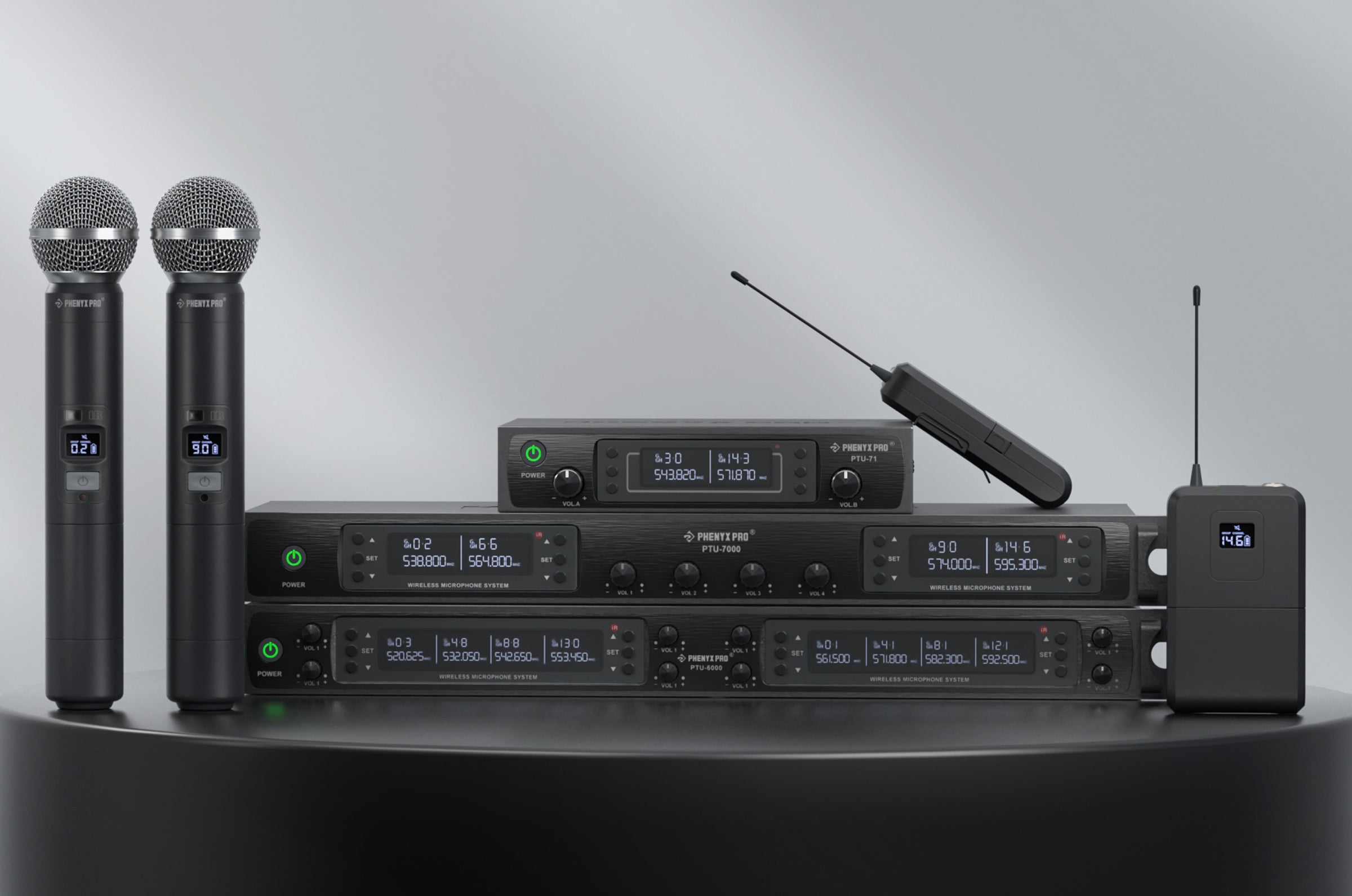
Presentamos los sistemas de micrófono inalámbrico PTU-71/7000/6000: libere el potencial inalámbrico
micrófonos inalámbricos Ofrecen una libertad escénica excepcional. Descubra el poder de la serie Auto-Scan UHF, uno de los más vendidos de Phenyx Pro Serie de sistemas de micrófono inalámbrico , para impulsar el potencial inalámbrico de su voz. En este blog aprenderás sobre este pulgar hacia arriba. Micrófono inalámbrico opción.
Learn More
